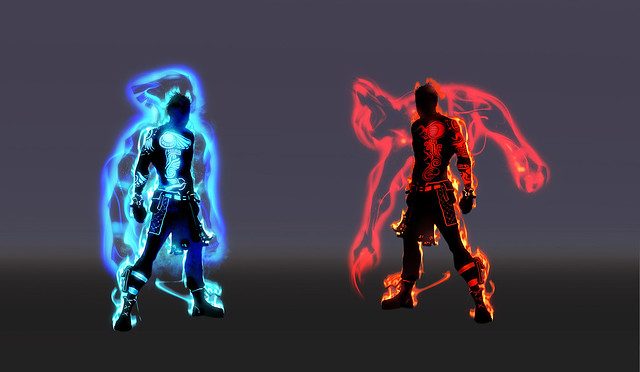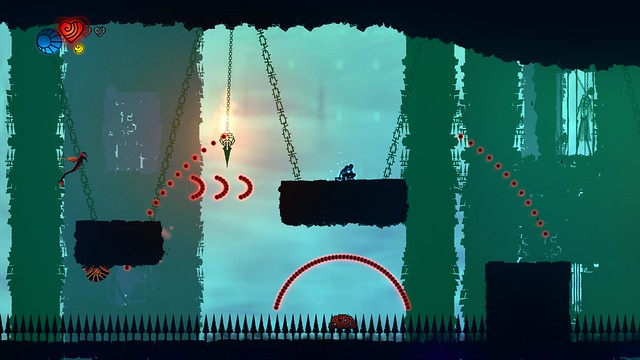As we are now about to release Outland, I thought it would be nice to share some thoughts on developing the game, especially on its main feature, the “Ikaruga” polarity mechanic. Thinking about it almost two years later, it feels like we came about the concept easily and naturally.

At the very beginning I had an idea on creating an action adventure platforming game that would give the player similar emotions and encounters I experienced when playing some of my favorite platforming games in the 80’s (Pitfall II, Jumpman Jr., Rick Dangerous etc. – see, I never had a NES). Early versions of Outland had a guy jumping, shooting and sliding around in a jungle environment. We expanded that basic gameplay by adding a special spirit mode that made the character move faster and cause more damage.
Our spirit mode, which we called the “Flow” mode, was one where you turned from a normal guy into a superhero; blue energy surrounded you and you were nearly invincible. We toyed around different variations of the concept, from having an additional boost mode, to having Flow sources/springs in the levels that would activate the spirit. Somehow the one-dimensional approach of the special power didn’t feel like enough. We decided on having some brainstorming sessions to further enhance the concept, but initially nothing caught on. Finally, during a weeklong meeting between Housemarque and Ubisoft, we started discussing applying Ikaruga’s mechanics to our 2D platforming, and Outland’s final concept was born!

Once we set ourselves on changing the spirit power to be binary, we had a very good feeling about it. Even if there hadn’t been many platformers with a similar feature (Silhouette Mirage, we know of you), we knew we could get it working. Just after a few weeks of development we had a prototype running and it confirmed our beliefs. Now the task was to fit this polarity mechanic into our existing concept.
Before coming up with the binary concept, we had had concerns about shooting working with fast, acrobatic movement. Now, on top of that, we had the environment and enemies shooting complex volleys of bullets at you, and you were supposed to make sense of what you were avoiding and where you were going while aiming at enemies. In addition, shooting required us to use the second stick, which made switching between aiming and jumping quite cumbersome. And that wasn’t all. Animating a human character who can jump around walls and point his arm to any and all directions at the same time proved to be especially hard.
The decision to drop the projectile weapons and stick with a melee attack proved to be the right one. Controlling the character became easier and more straight-forward, and now the experience started to be more about player skill than the controls handicapping the game. The final debate we had before going into full production was to decide which way the player’s energies worked against enemies and items.

The development team was torn half between the same color hurting enemies versus the opposite color doing so. To me, it felt more natural to use the same color (for everything), but two specific things convinced us decide on the opposite. First, we realized we could get more diversity from players having to switch between modes when fighting enemies, jumping on colored platforms and absorbing bullets; also, all of those items being of alternate color looked better. Second, Ikaruga had also gone the ‘opposite’ route and that was good enough final confirmation for us.
One major thing we did differently from Ikaruga was the inability to hurt enemies of the same color. We tested different damage ratios between half damage and one sixth, but none of them made it clear enough that the player should switch alignments for stronger attacks. Ultimately, going full-on binary clarified gameplay and enabled us to create encounters where the intent was clean. Once we had that final thing settled, we had all of our core mechanics nailed down and moved from prototyping onto full-on production.
The end result you can all judge by yourselves. I and the rest of the team truly hope you enjoy Outland when it hits the PlayStation Store on June 14.
Related Posts:
- Rumor: Halo 4, Halo: Combat Evolved Anniversary revealed early by Microsoft - joystiq
- Rumor: Kinect Xbox Live voice search coming to Xbox 360 - joystiq
- EA E3 2011 keynote, live from The Orpheum - joystiq
- Outland will be out on PSN June 14 - joystiq
